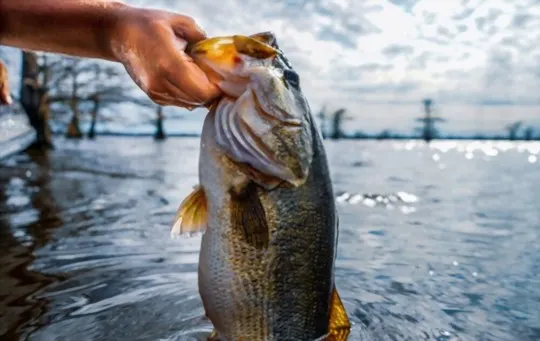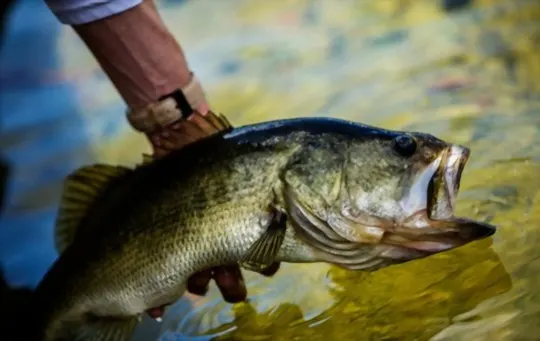If you’re a fan of seafood, then bass is likely something that’s on your must-try list.
But what does it really taste like? To answer this question, we’ve put together a comprehensive guide to the flavors and textures of bass.
From the type of fish to how it should be cooked, we’ll explore all of its nuances so that you can gain a clear understanding as to why this delicate yet flavorful fish has gained such popularity.
With our tips and tricks, you’ll soon have an intimate relationship with bass in no time!
What is Bass?

Bass fish are some of the most revered and sought-after fish for recreational anglers around the globe.
They’re highly sought after for their fight, strength, and size, making them an incredibly fun and rewarding fish to target.
Bass come in many shapes and sizes, from smallmouth bass that inhabit rocky mountain streams, to largemouth bass that inhabit vast shallow lakes.
The average size of bass ranges anywhere from 1 pound to 15 pounds and they generally favour murky near-shore waters where they can ambush their prey.
In addition to their size and fighting abilities, bass are popularly known for their impressive jumping abilities which can help them quickly flee danger.
All in all, Bass fish is one of the most popular game fishes in the world due to its wide availability and fantastic qualities as a trophy catch.
What Does Bass Taste Like?

Bass has a mild, white, and flaky flesh that tastes slightly sweet and buttery with a subtle earthy and nutty flavor.
Bass can be prepared in a variety of ways, from grilling to pan-searing or baking, and can be seasoned with a range of herbs and spices to enhance its flavor profile.
However, the taste of bass can also depend on other factors, such as the species of the bass, their habitat, and their diet.
For example:
- Striped bass: A popular game fish with firm and meaty flesh that tastes sweet and mild.
- Largemouth bass: A freshwater fish with a tender and flaky texture that tastes slightly sweet and earthy.
- Smallmouth bass: A freshwater fish with a lean and firm texture that tastes slightly nutty and sweet.
When selecting bass, it is essential to consider the source and method of catch as well, as these factors can affect the taste and quality of the fish.
For the freshest and most flavorful bass, consider purchasing from a reputable seafood market or catching it yourself, ensuring that it has been stored and transported correctly.
To enhance the flavor of your bass, try marinating it with lemon or lime juice, garlic, and herbs before cooking.
Factors that Affect the Taste of Bass

Bass is a versatile and flavorful fish that has a delicate and mild taste.
However, several factors can impact its taste, including:
- Water source: The quality of water where the bass was caught can significantly influence its taste. Bass caught in cleaner water sources usually have a cleaner and sweeter taste, while those caught in polluted waters may have a muddy or off taste.
- Diet: Like any other animal, the diet of the bass can affect its taste. Bass that feed on a variety of smaller fish and crustaceans tend to have a more flavorful and meaty taste, while those that feed on plant matter may have a more delicate and mild taste.
- Cooking method: The cooking method you use can affect the taste of your bass. Grilling or broiling the fish brings out its natural sweetness and enhances its flavor, while deep-frying or overcooking the fish can make it dry and tasteless.
- Age and freshness: Freshness is key when it comes to seafood, and bass is no exception. The longer the fish is out of the water, the weaker its taste becomes. The age of the fish can also impact its taste, with older bass having a stronger and more pungent flavor.
- Seasoning and marinades: The seasoning and marinade you apply to your bass can affect its taste. A simple seasoning of salt, pepper, and lemon juice can enhance the natural taste of the fish, while a marinade with stronger flavors can overpower the delicate taste of the bass.
Keeping these factors in mind and experimenting with different styles of cooking and flavoring can help you find the perfect taste for the bass.
1 – Type of Bass
Bass is a freshwater fish known for its mild flavor and tender, flaky meat.
It has a subtle sweetness and pairs well with a variety of seasonings and flavors.
There are many types of bass, each with its unique flavor profile:
- Striped Bass: Striped bass has a delicate, flaky texture and a mild, sweet taste. It is often used in sushi and sashimi dishes.
- Largemouth Bass: Largemouth bass has a firmer texture and a mildly sweet flavor with a hint of earthiness. It is commonly used in fish fries and stews.
- Smallmouth Bass: Smallmouth bass has a firmer texture and a slightly sweet flavor with a hint of nuttiness. It is often grilled or baked.
- Spotted Bass: Spotted bass has a delicate, flaky texture and a slightly sweet taste. It is commonly used in fish tacos and chowders.
Bass is an excellent source of protein and omega-3 fatty acids, making it a healthy addition to any diet.
To get the most out of your bass, be sure to store it properly and cook it to the appropriate internal temperature.
For a unique twist, try adding citrus or herbs like thyme or rosemary to your bass dishes to enhance its natural flavor.
2 – Diet
Diet plays a crucial role in determining the taste of fish, including bass.
The diet of bass influences its flavor and texture, making it important to know what bass eat to understand its taste profile.
Here are some common types of diets for bass and how they affect flavor:
- Carnivorous Diet – Bass that feed mainly on smaller fish like shad and minnows tend to have a mild, clean flavor.
- Vegetarian Diet – Bass that feed on plants and insects tend to have a herbaceous flavor and may have a softer texture.
- Bottom-Feeding Diet – Bass that feed on crustaceans, worms, and other organisms on the bottom of lakes and rivers tend to have a muddier flavor and firmer texture.
It is important to also note that the taste of bass can vary depending on the region and water source from which it is harvested.
To enhance the flavor of bass, try cooking it with herbs like thyme, rosemary, or dill and serve with a squeeze of lemon.
3 – Habitat
Habitat plays a significant role in how bass tastes, as this species tends to take on the flavors of the environment in which it lives.
Largemouth bass, for example, are found in freshwater areas and tend to have a mild, slightly sweet flavor with a firm texture.
They are often compared to the taste of trout or perch.
However, if caught in a muddy or weedy area, their taste may be compromised and have a slightly earthy flavor.
On the other hand, striped bass are found in both freshwater and saltwater environments and have a mild, sweet flavor with a flaky texture.
Their taste will vary depending on where they were caught and what they were feeding on.
Overall, bass is a versatile fish that can be cooked in a variety of ways, including grilling, baking, or frying.
It is often recommended to pair bass with bold flavors such as garlic, lemon, or herbs to enhance its natural taste.
How to Cook Bass to Enhance its Flavor?

Bass has a mild, sweet, and delicate flavor that can be easily enhanced with the right cooking techniques.
Here’s a step-by-step guide on how to cook bass to enhance its flavor:
- Season the fish generously with salt, pepper, and herbs or spices like rosemary or thyme.
- Preheat your oven to 375°F (190°C).
- Heat a skillet over high heat and add a tablespoon of butter or oil.
- Add the bass to the skillet, skin side down, and sear for 2-3 minutes until the skin is crispy and golden brown.
- Transfer the skillet to the preheated oven and bake for 8-10 minutes until the fish is opaque and cooked through.
- Remove the fish from the skillet and let it rest for a few minutes before serving.
You can also grill or broil the bass for a delicious smoky flavor.
Serve the fish with a side of roasted vegetables or a bed of rice for a healthy and satisfying meal.
To reduce the fishy taste and smell of bass, soak it in milk for 30-60 minutes before cooking.
The lactic acid in the milk neutralizes the fishy odor and adds a creamy texture to the fish.
Where to Buy Bass and How to Store It?
Bass is a delicious freshwater fish that has a mild, delicate flavor and a firm, flaky texture.
If you’re wondering where to buy bass, you can find it in most grocery stores, fish markets, and online seafood retailers.
When choosing bass, look for fish with firm, shiny skin, clear eyes, and a fresh scent.
To store bass, rinse the fish in cold water and pat it dry with paper towels.
Wrap the fish in plastic wrap or aluminum foil and store it in the refrigerator for up to two days.
For longer storage, you can freeze bass for up to six months.
To freeze bass, rinse the fish in cold water, pat it dry, and wrap it tightly in plastic wrap and/or aluminum foil.
Place it in a freezer-safe container and label it with the date.
Conclusion
In conclusion, bass has a mild and delicate flavor with a slightly sweet and buttery taste.
Its meat is firm, low in fat and flaky, making it easy to cook and pair with different flavors.
Depending on the species and habitat, bass can have a slightly different taste profile.
For instance, largemouth bass are more flavorful and have a firmer texture compared to the milder and softer smallmouth bass.
If you want to enhance the flavor of bass, seasoning it with mild herbs, lemon, or garlic can make a big difference.
Bass is a versatile fish that can be grilled, baked, fried, or sautéed, making it a popular choice for different recipes ranging from appetizers to main courses.

What Does Bass Taste Like? A Comprehensive Guide
Ingredients
- Bass
- Ingredients from your selected recipes
Instructions
- Select your favorite ingredient from the range available in this article.
- Collect all the necessary items to make the recipe.
- Use the instructions provided to prepare a delicious dish in 30 minutes or less.

Carrie is a food writer and editor with more than 15 years of experience. She has worked for some of the biggest names in the food industry, including Bon Appétit, Food & Wine, and Martha Stewart Living.
As the Editor in Chief of IntroChicago.com, Carrie oversees all of the content on the site. She also manages the team of contributing writers and editors, who help to create delicious recipes, helpful tips, and informative articles that you’ll find on the site.
A native of the Chicago area, Carrie is passionate about all things food. She loves trying new restaurants and experimenting with new recipes in her kitchen. She’s also a graduate of the Culinary Institute of America, so she knows a thing or two about food!
